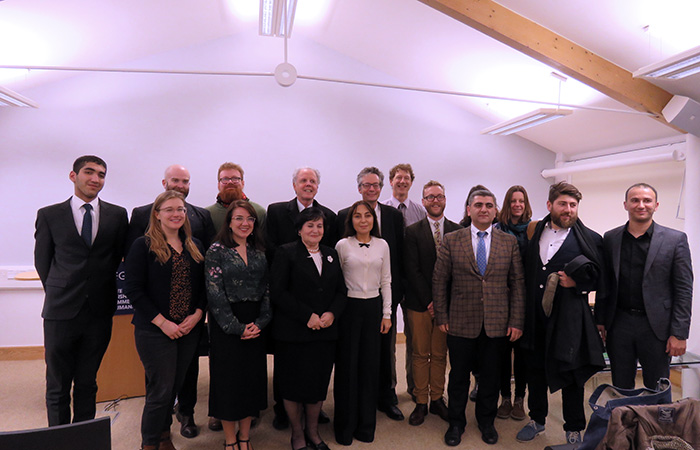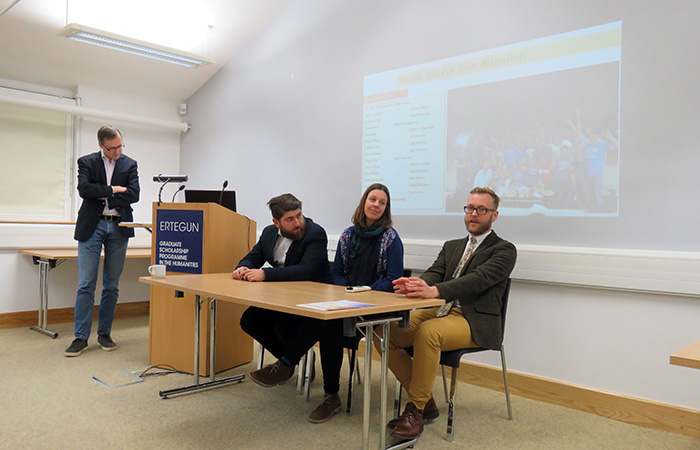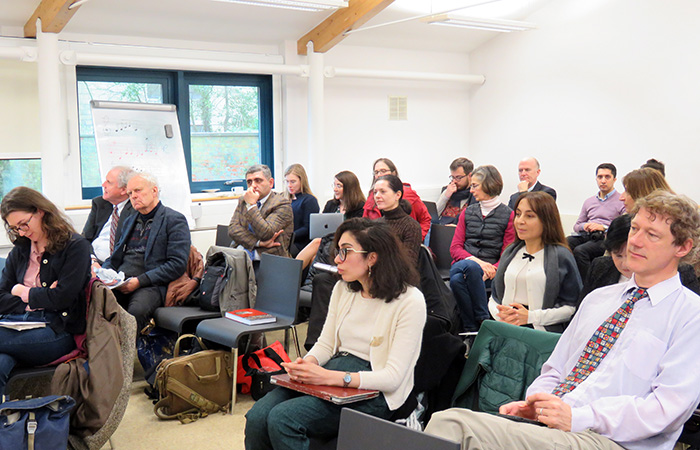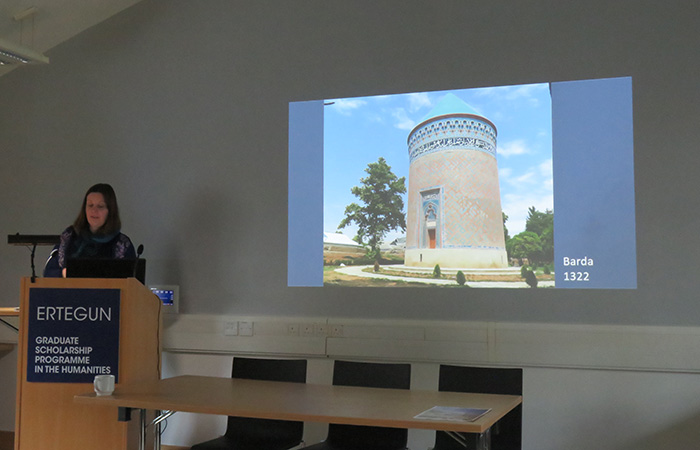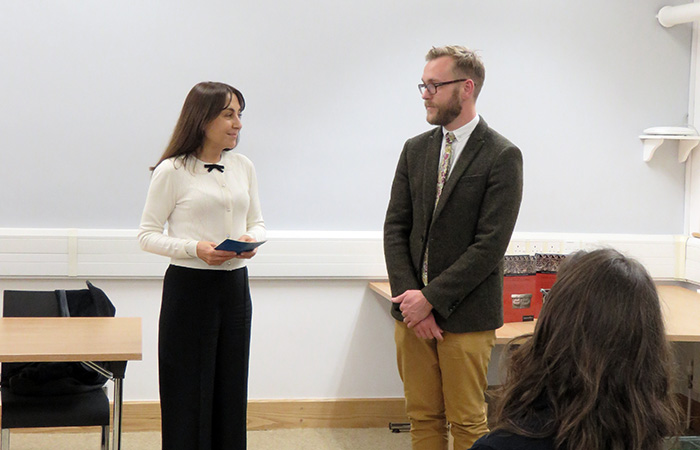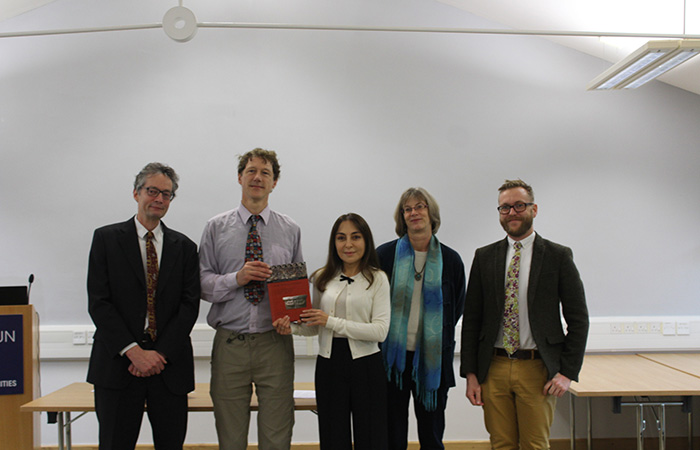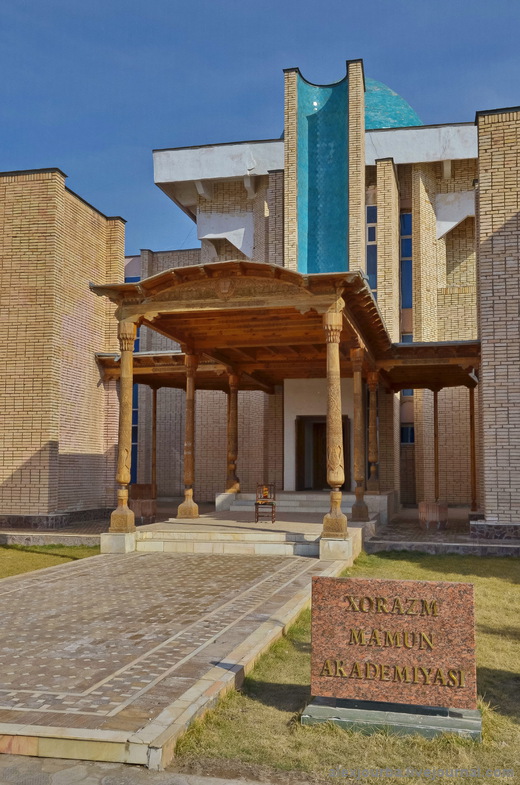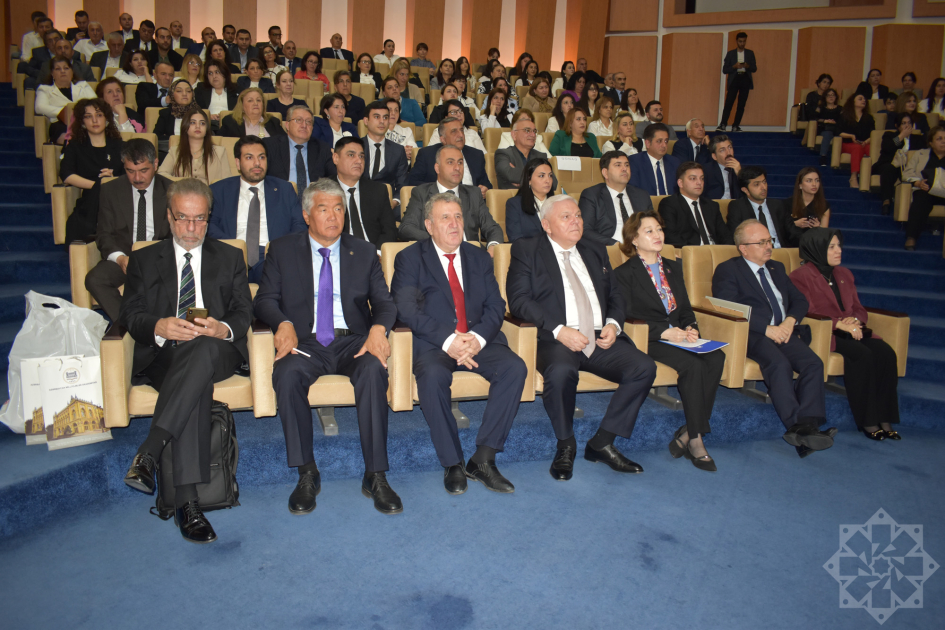- A-
- A
- A+
Ertegun House Center under Oxford University of Great Britain holds a colloquium on archeology of the medieval city of Barda
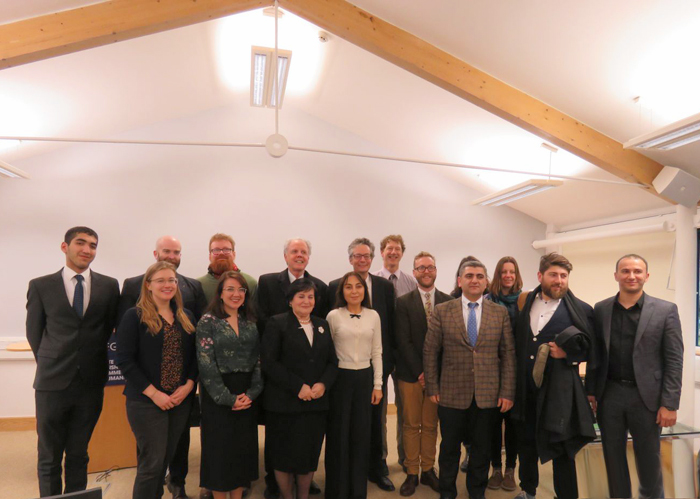
A colloquium on archeology of the medieval city of Barda was held on February 27-28, 2020 at the Ertegun House Center under Oxford University of Great Britain.
The project “Archaeological Studies of Barda” is one of the important scientific initiatives of the Oxford Center Nizami Ganjavi, created in 2013 on an ongoing basis in the structure of Oxford University - the oldest and most authoritative university in the world, with the aim of studying the history, languages and cultures of Azerbaijan, the Caucasus and Central Of Asia. Among the many interesting projects implemented by the Center, such as translating scientific works at a high academic level, organizing international conferences, studying manuscripts, preparing graduate students and undergraduates, archaeological research in the city of Barda occupies a special place. One of the main goals of archaeological expeditions is to bring to the world scientific community more complete information about the ancient heritage and rich history of the Azerbaijani city. The day before the start of the Colloquium, a lecture was held by Scott Redford, representing the Department of Art History and Archeology at the Halili Research Center of the University of Oxford, a professor at SOAS University. The topic of the lecture is “Medieval South Caucasus (XI-XIII centuries)” Within the framework of the Colloquium program, 4 scientific sessions were held in which participants of the Bardinian archaeological research spoke.
With a welcoming speech, the dean of the Faculty of Oriental Studies at Oxford University, professor of Tibetan and Himalayan studies Ulrike Rosler and Rector of the Baku branch of Moscow State University named after him welcomed Colloquium. Lomonosova, Vice President of the National Academy of Sciences of Azerbaijan (ANAS), Member of the Board of the Scientific Center of Nizami Ganjavi, Oxford University (www.orinst.ox.ac.uk/nizami-ganjavi-programme-study-languages-and-cultures-azerbaijan-and- caucasus) Academician Nargiz Pashayeva.
Addressing the participants, Professor Nargiz Pashaeva, in particular, said:
- Dear colleagues and guests, I am happy to see you all here. I am sure that the Barda archeology colloquium will be interesting and useful. It will contribute to the exploration of the Caucasus and will fill in certain gaps that have taken place. In addition, the Barda project unites people and cultures. This fall, we plan to hold a seminar and an exhibition on the results of the work carried out in Barda in Baku, the Institute of Archeology of Azerbaijan.
I would also like to say a few words about the history of Azerbaijani archeology.
During the People Republic of Azerbaijan, December 7, 1919, in honor of the first anniversary of the Parliament of Azerbaijan, the Museum of Independence was created. This museum was opened in the parliament building and exhibits displayed during archaeological research were presented. In 1920, the Museum of the History of Azerbaijan was created on the basis of this museum. Thus, the foundation was laid for the future development of archeology in our country. At that time, the head of the museum was the first representative of the national archaeological school, historian and ethnographer Davud bey Sharifov. In 1920, this museum organized the first archaeological research in Azerbaijan - in the complex of the Shirvanshahs and the Maiden’s Tower in Baku. Thus, today we are witnessing the 100th anniversary of the first archaeological project in Azerbaijan. Since the administrative center of the Caucasus was Tiflis in the era of the Russian Empire, many archaeological finds from the whole region were sent to the Caucasus Museum located in this city. In 1925, at the initiative of Davud Sharifov, part of the exhibits was transferred to the Museum of the History of Azerbaijan. Among those exhibits there are a number of very interesting ones. For example, materials about Redkin Lager or some information about Friedrich Bayern, who was invited by the Russian Empire. These materials are currently stored in the Museum of History of Azerbaijan.
Unfortunately, the archaeological science of Azerbaijan was not widely represented at the international level. We can only remember the exhibition in France in 1981 and 1982, in the Islamic Museum of Paris, where exhibits of ancient settlements were presented. The Soviet Union then presented only one exhibit - from the Azykh cave in Azerbaijan, discovered by archaeologist Mammadali Huseynov.
I would also like to mention the Azerbaijani scientist Isa Selimkhanov. Despite the Soviet ideology, which, as you know. did not support the independent promotion of local specialists, in 1987 Selimkhanov was elected a member of the German Archaeological Institute, was a member of the Archaeological Society at the University of California and an Honorary Member of the English Metallurgical Society. In 2002, his scientific works were included in the Zana Dai online catalog.
In conclusion, I would like to thank all my colleagues, especially Prof. Edmund Herzig and Dr. Paul Wordsworth, as well as express gratitude to all who support us.
Thank you for your attention and wish you a successful seminar!
Following the presentation by Professor Nargiz Pashayeva, famous scientists - participants of archaeological research in the city of Barda, spoke about the excavations they conducted in the area.
At the first session, dedicated to the history and historiography of Barda and Arran, a professor at the Institute of Oriental Studies at Oxford University, Edmund Herzig, delivered a lecture entitled "Writing the History of Medieval Azerbaijan."
Then, on the topic “Archeology of the medieval period in Azerbaijan”, the director of the National Museum of Azerbaijan History, Doctor of historical sciences, academician Naila Velikhanli spoke.
The second session, devoted to the topic “Archaeological approach to the research of Barda and landscapes of medieval cities in Azerbaijan”, was presented by the speeches of three scientists.
The report “Urban Landscape of Barda, 600-1200” was made by Paul Wordsworth, scientific researcher at Brasenos College, Oxford University, team leader of the Barda Archaeological Expedition.
“Mongols in the cities of the Caucasus” was the name of the study by Katie Campbell, a specialist in archeology of Central Asia, Islamic archeology, and archeology of the Caucasus from the School of Archeology of the University of Oxford. The speech of the Georgian archaeologist, representative of Tbilisi State University, David Naskidashvili, contained an overview of the practice of excavating the medieval Caucasus.
The topic of the third session, “Bioarchaeological evidence from the city of Barda,” was disclosed in the reports of the zooarchaeologist, specialist in the field of geometric morphometry from the University of Exeter in Britain, Honorary Research Fellow at the Halle-Wittenberg University named after Martin Luther Ashley Haruda - “Features of Nutrition and Economics of the medieval Barda”; David Stone, Roman North Africa and Landscape Archeology Specialist for the University of Michigan, Archaeobotanical Traces Discovered in the City; Dr. Celine Nugent, an employee of the Institute of Ancient World Studies, New York University, a researcher of the diet and assortment of products of the ancient population, which presented data on human remains in Barda and its outskirts - Garatepe.
In the fourth session, entitled “Barda’s Material Culture”, Timothy Penn, a researcher at the School of Archeology of the University of Edinburgh, and a researcher at the National Museum of Azerbaijan History, a teacher at the History Department of Baku State University Aslan Gasimov made a presentation “Glass vessels and jewelry from the medieval Barda”. The report of which contained an overview of the available materials on Barda at the National Museum of History.
Recall that since 2015, under the leadership of archaeologist-researcher at Brasenos College of Oxford University Paul Wordsworth, in the city of Barda, in the territories of Garatepe and Torpaggala, annual archaeological work was carried out with the participation of representatives from Oxford and Edinburgh universities, the University of Pennsylvania USA, Dublin University of Ireland, Galle -Wittenberg University of Germany, Copenhagen University of Denmark, Tbilisi State University of Georgia, as well as from organizations such as Islamic Art Doris Duke Foundation for the Islamic Art (USA), York Archaeological Trust and the Heritage Without Borders of Britain, American Research Center in Sofia Foundation )
The expedition included an employee of the Museum of History of Azerbaijan, a teacher of the history department of Baku State University and two students of the history department of BSU. In total, 24 archaeologists took part in excavations and studies.
Fragments of material and cultural samples discovered during archaeological excavations in Barda in March 2018 and April 2019. were partially sent to the University of Oxford for scientific and laboratory research. In the territory of the Bardinsky district called Garatepe, a settlement dating back to the V-VI centuries was discovered.
Note that the territory of Garatepe for the first time became the object of scientific study in the framework of the Barda archaeological research project. Part of the material found during the excavations was also subjected to radiocarbon analysis, which established that these artifacts date from the end of the V-beginning of the VI centuries. Excavations in Garatepe became a serious step towards studying the rural life of the settlement during the early Middle Ages.
At the end of the conference, the initiators and participants of the event shared their opinions and impressions.
Edmund HERZIG, Professor, Institute of Oriental Studies, University of Oxford:
- Azerbaijan has a rich history and culture. There are a lot of interesting places for archaeological excavations, there is a magnificent written heritage. So far, all this is little known and studied, especially in the West. Of course, unlike the West, in the Soviet Union, including Azerbaijan, this was paid much more attention. One of the goals of our Center is to carry out work in this area with the involvement of a large number of Western students and scientists, as well as to assist them in their research activities in Azerbaijan. At the same time, it is very important to provide people with the opportunity to communicate with each other so that we can learn as much as possible about the studies conducted in Azerbaijan, including those conducted during the Soviet era, and that our Azerbaijani colleagues can maintain closer contacts with workers in the West.
Prof. Nargiz PASHAEVA:
It was a unique project. Why? Because for the first time we carried out excavations in the city of Barda - at a scientific level and with the participation of a group of international experts, of course, in the context of the research and educational process of the Nizami Ganjavi Center, which studies Azerbaijan, the Caucasus and Central Asia, located in the Oxford University structure. For the first time we received information about the medieval and early medieval period in the territory of Garatepe in Barda. This work began in 2013 and continued until 2018, that is, it was carried out over four seasons. In fact, the greatest value of the project lies in the fact that it is connected with Azerbaijan precisely as a study of the University of Oxford, it is a project capable of representing our scientific interests at the highest level. Yes, we carried out archaeological excavations in Barda, and the results of these studies were presented precisely by the University of Oxford. The names of Azerbaijani scholars who made a great contribution to the development of the archeology of Azerbaijan were voiced at this Colloquium, and I consider this an extraordinary event in itself as an event that took place at such an authoritative forum. Unfortunately, the names of our scientists are not mentioned in the status of scientific structures that carry informative information about scientists in English. But, I repeat once again - they were made here in speeches that will remain in the protocols and documents forever. And it is gratifying!
Paul WORDSWORT, Researcher at Brasenos College, University of Oxford, Team Leader, Barda Archaeological Expedition:
- The most valuable part of the finds that we discovered during the bardine excavations dates back to the XI, XII, and XIII centuries. At that time, the State of Eldegizler ruled in Azerbaijan. What we have identified relates to an important period in the history of Azerbaijan - vivid in economic and significant in political terms. We found materials showing that in Azerbaijan, at a distance from the trade of Iran and Anatolia, shopping centers were concentrated, and also showing that this city was the cultural center of the whole country. This year we plan to publish a book with the aim of publishing the results of archaeological excavations in Barda, as well as disseminating important information regarding artifacts stored in the National Museum of History of Azerbaijan. Reviews of this book along with Azerbaijani and Russian will be printed in English. We do not want to be a Center exploring exclusively the medieval Caucasus. We have many scientists who study various aspects of the Middle Ages - history, literature and archeology. We currently have the Nizami Ganjavi Center for Azerbaijan, the Caucasus and Central Asia. And we want to increase the number of scientific works of students and teachers studying the Middle Ages in this region, since, unlike the English-speaking world, this topic has been widely studied in Azerbaijan and Russia, and we want to help expand it with us.
Academician Naila Velikhanli, director of the National Museum of the Azerbaijan History:
- Azerbaijani scientists have been engaged in archaeological research of Azerbaijani cities since about 1920. However, this great interest in the history of Azerbaijan, shown by foreign scientists, especially Western European ones, is the best opportunity for introducing Azerbaijan to the world. Both British and Azerbaijani scientists took part in the Barda archaeological expeditions organized by the Nizami Ganjavi Scientific Center of the University of Oxford, and today we see the results of their joint activities. British scholars are interested in the history of Azerbaijan not only in the aspect of archaeological research, but also in who it is studied by, they study the works of Azerbaijani historians.
Scott REDFORD, professor at SOAS University:
- Despite the fact that the topic of the Colloquium is excavations conducted in Barda, issues related to the Middle Ages throughout Azerbaijan were examined here. Unfortunately, I have never been to Azerbaijan, but I know that your country has a very rich history. There are many interesting ceramic, glass and metal objects, in connection with which I have put forward proposals at the conference. I propose to compile and publish a book from the collected materials relating to this period, with its subsequent translation into English by Oxford Center named after Nizami Ganjavi. Because we really want to study the history of the Middle Ages in Azerbaijan.
Mirjavid AGALAROV, student of the Faculty of History, BSU:
- As a student at Baku State University, it was extremely interesting for me to work with specialists from Oxford University. The history of medieval Barda is a little studied topic, so participation in such a large-scale research fills me with a sense of pride. The result of my work in the archaeological expedition group was my participation today at this conference, which is a great achievement for me, and which I am immensely happy about.
©All rights are reserved. Citing to www.science.gov.az is necessary upon using news.
Similar News
Links
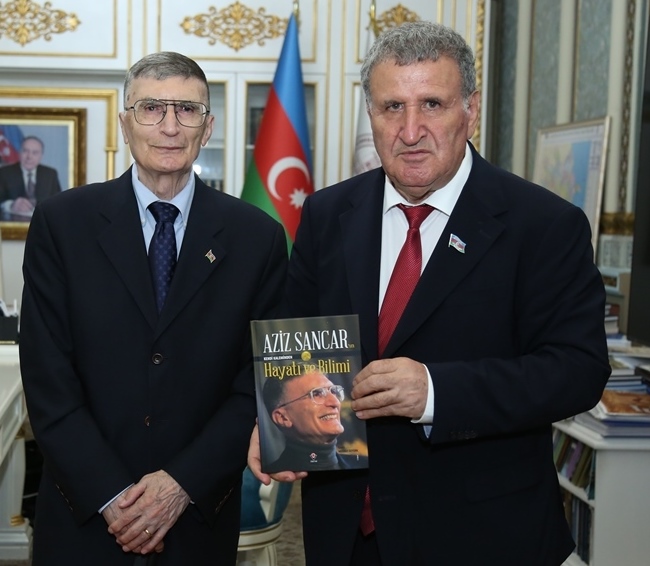

 Elm TV
Elm TV
 Photo
Photo
 Video
Video
